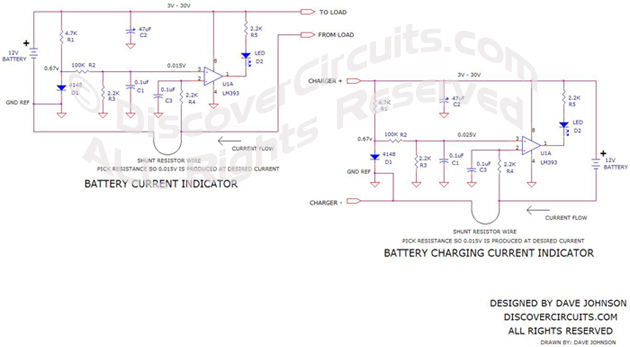|
 |
DiscoverCircuits.com -- Hobby Corner
Last Updated on:
Friday, December 29, 2017 05:52 AM
Hobby Circuits List
The contents &
graphics of Discovercircuits.com are copyright protected.
LINKING to Dave's circuits is permitted but DO NOT COPY any files to your WEB
SITE server |
|
|
|
|
|
DC CURRENT INDICATOR #4
December 15, 2008
The circuit below uses some common components to turn
on an LED whenever DC current above a certain level is detected. The circuit uses
a very popular LM393 dual voltage comparator from National Semiconductor and a common
1N4148 signal diode. The diode acts as a crude 0.7v voltage reference. Only
one of the comparators inside the 8 pin package is used. A pair of resistors
across the diode forms a voltage divider, which produce a reference voltage of about
0.015v. The circuit compares this reference voltage to a voltage produced across a
current shunt resistor. A section of wire already in place can be used as the
current shunt. The circuit can be used to indicate current drawn from a battery
and routed to a load or current from a battery charger to the battery. Both circuits are
shown on the drawing. The circuit shows components for a 12v system but it will work
well using any DC supply from 3v to 30v. |
|
The circuit is sensitive enough that
it can indicate fairly small currents through a section of thick wire.
As an example, an 18ga wire only 24 inches long will have a resistance of about
0.013 ohms. The needed 0.015 volts will be generated with a current flow of
about 1.2 Amps. If more sensitivity is needed, a longer section of wire can be used
as a shunt resistor.
Use Ohmís Law to calculate the
resistance needed. Ohmís Law equation is: E = RI, where R is the resistance in
ohms, E is the voltage developed across the resistance in volts and I is the current
flowing through the resistor in Amps. If we set E at 0.015 volts and R at
0.0012 ohms, then I = 1.2 Amps. |
|
|
| Here is one
example how this circuit might be used. Suppose you have a large 12v battery,
which supplies current to various loads inside a recreational vehicle (RV). You
noticed that a 10ga wire 10 feet long connects the battery negative terminal to a
junction box. You look up the resistance of the 10ga wire from a chart and find
out that the typical resistance is about 0.001 ohms per foot. Therefore, if you
used the battery negative terminal as one point of reference and the connection in the
junction box as another point, then the resistance should be about 0.01 ohms. If
the current indicator circuit were connected between those two points, then the circuit
should switch on the LED whenever current exceeding 1.5 Amps is drawn from the battery.
|
| In another
example, suppose you have a battery changer connected to a 12v lead acid battery.
The charger uses a pair of 18ga wires 12 feet long. The resistance of 18ga wire is
about 0.0064 ohms per foot, so the resistance of one of the 12 foot wires should be
about 0.077 ohms. Using the current indicator circuit and using the two ends of
the cable as reference points, the LED should turn on whenever the charging current
exceeds 0.20 Amps. The indicator light should turn off when the battery is fully
charged. |
|
Here is a link to a
Table for
Copper Wire |
| |
|
Click on Drawing Below to view PDF
version of Schematic |
|
 |